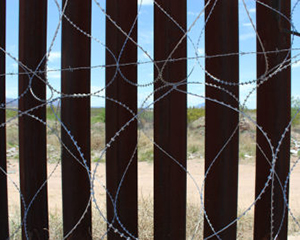DHS Border Wall Remediation Plan Fact Sheet
The Department of Homeland Security (DHS) published an update on its border remediation plan, and it’s not good!
On July 11, 2022, DHS announced plans to install or complete lighting on existing 30’ border wall. This puts approximately one-quarter (455 miles) of the southwestern border at severe risk of light pollution where border wall was built between 2017-2021 (see list of public lands affected by border wall and waivers of law below).
Border lighting, if completed, will have damaging and deleterious effects on environmental and human health in ways similar to the border wall itself. Importantly, public lands in the U.S. borderlands like National Wildlife Refuges and National Parks, are valued for their remote and scenic landscapes. Artificial lighting systems will negatively impact these lands through harmful environmental and human health impacts in ways similar to the border wall itself.
Artificial illumination of the border would inflict new environmental damage on hundreds of species that migrate through North America each year and reside in borderland forest, grassland, and desert habitats. As Longcore and Rich (2004) write, “a ‘perpetual full moon’ from artificial lights will favor light-tolerant species and exclude others.” Further, artificial bright light at night will negatively impact wildlife in a variety of physical and behavioral ways:
- Disorients migratory birds, increasing their risk of fatal collisions, predation, and exhaustion along flyways.
- Disrupts vocal communication of species like coyote that vocalize most on darkest days to establish territory and hunt together.
- Attracts and concentrates insects including pollinators, making them more vulnerable to predation by animals that hunt at night.
- Increases competition between species for dwindling resources, such as fast-flying bats that follow the concentration of insects towards artificial lights while slow-flying bats avoid lighted areas.
- Repels species that prefer darkness, such as the lesser long-nosed bat that avoids areas of high light pollution.
- Reduces foraging behavior in small animals including rodents, rabbits, and snakes.
Artificially illuminating hundreds of miles of border would compound the environmental stress of North American wildlife species that are already suffering severe impacts of drought and blocked by the physical wall from finding water, food, shelter, and mates on the divided landscape.
In addition to devastating impacts on wildlife and the environment, this lighting could have negative consequences on human health. Spillover lighting and skyglow contributes to light pollution which has adverse effects on humans, disrupting circadian rhythms, suppressing melatonin production, and leading to increased risks of sleep, mood, and metabolic disorders.
Stadium lighting projects should not be completed in the DHS remediation plans, especially on protected lands established to safeguard wildlife. The U.S. borderlands are some of the last remaining spaces untouched by unnatural artificial light.
PUBLIC LANDS AFFECTED BY THE BORDER WALL AND WAIVER OF LAWS
- Tijuana River Reserve, California (USFWS, NOAA and California State Parks) (globally recognized estuary supporting high bird diversity being adversely affected by erosion from wall construction).
- Otay Mountain Wilderness area in California (BLM, cross-border wildlife area, roads were built inside the wilderness boundary to facilitate wall construction; endangered Tecate cypress).
- Imperial Sand Dunes Recreation Area/Algodones Dunes, California (BLM) habitat for flat-tailed horned lizard, wetlands at the border).
- Cabeza Prieta National Wildlife Refuge, Arizona (USFWS, third largest national wildlife refuge in the lower 48 states; 95% wilderness; Sonoran pronghorn, Tribal sites).
- Organ Pipe Cactus National Monument, Arizona (NPS, critical desert springs with endemic endangered desert fish, Sonoran desert tortoise habitat, cactus ferruginous pygmy owl, significant tribal sites).
- Buenos Aires National Wildlife Refuge, Arizona (USFWS, cactus ferruginous pygmy owl masked bobwhite quail, significant historic and cultural resources).
- Coronado National Memorial, Arizona (NPS, high species diversity, significant historic and cultural resources, AZ trail).
- San Pedro Riparian National Conservation Area, Arizona (BLM, last south to north free flowing river in Arizona; important habitat and wildlife corridor, significant historic and cultural resources).
- Coronado National Forest, Arizona (Forest Service, highest species diversity in the entire national forest system, jaguar and ocelot habitat).
- San Bernardino National Wildlife Refuge, Arizona (in vicinity of jaguar crossings; unique cross-border wetlands/cienegas, significant historic and cultural resources).
- Guadalupe Canyon Wilderness Study Area, Arizona, (BLM, internationally recognized birding area, endemic species or species found no where else in U.S.).
- Antelope Wells and other BLM lands, New Mexico (where unique desert bison herd crosses the border, along with pronghorn and Mexican wolf habitat).
- Lower Rio Grande National Wildlife Refuge, Texas (114 separate Refuge tracts with most of the last remaining natural habitat in the Rio Grande Valley, riparian habitat, high bird diversity, ocelots; ecotourism).
Congress must rescind any remaining DHS funding for construction of the border wall and related infrastructure—including for lights and enforcement zone development—and provide those resources to the Department of Interior and other agencies to repair and restore border lands and communities. Unless and until this happens, more walls and related damaging infrastructure will be built—and the damage being done by the border wall will only get worse.
Sample Phone Script—DHS Border Wall Remediation Plan

